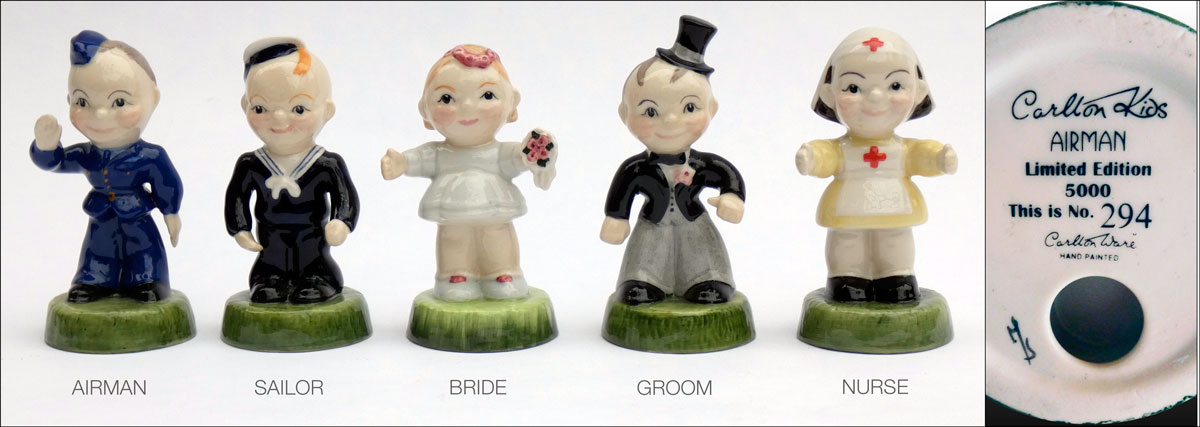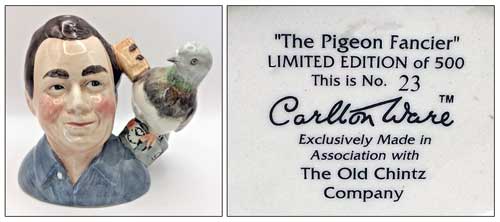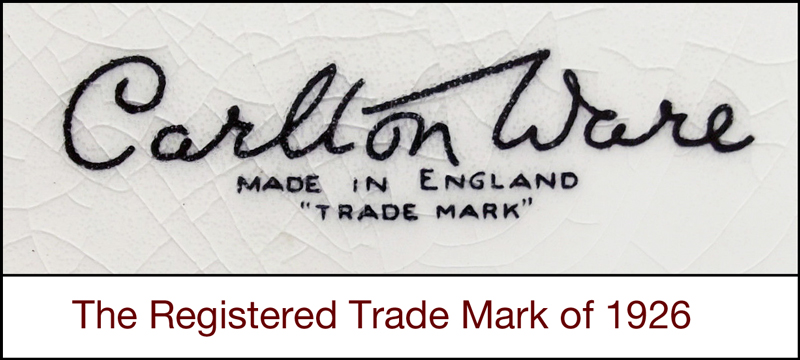This article details what happened to Carlton Ware’s registered trademark after the Pottery closed in 1989 following voluntary liquidation.
The closure and sale of the Pottery eventually led to the building known as the Carlton Works being sold and subsequently converted into student accommodation and workshops. Below is a picture taken in 2007, much as it is today. Click or tap on the image to enlarge. Notice the inset showing the "ghost sign" above the goods entrance and porters lodge at the side of the building.

Notice the inset showing the "ghost sign" above goods entrance and porters lodge at the side of the building.
To return to this page use your back button.
The 1989 Liquidation of Carlton Ware
During the voluntary liquidation, Carlton Ware's pattern and shape books, selected moulds, goodwill, and—most significantly—the registered trademark were sold to John McCluskey. Limited production of Carlton Ware continued at Mr. McCluskey’s factory on an industrial estate in Stone, approximately ten miles away from Stoke, where he produced ceramic hardware for doors and furniture. However, his Carlton Ware enterprise was short-lived, ending after three years or so, around 1992.
In 1997, following several years of dormancy, Mr. McCluskey sold the Carlton Ware trademark to the London-based Francis Joseph Salmon. The trademark—now commonly referred to as the Script backstamp—was originally registered by Cuthbert Wiltshaw in 1926 and is shown at the beginning of this article.
Francis Joseph Salmon –
trading as Francis Joseph
During his ownership of the registered trademark, Mr. Salmon—who had only limited experience with pottery and did not produce any himself—outsourced manufacturing to several Staffordshire-based producers, including Bairstow Manor Pottery, Moorland Pottery, and Peggy Davies Ceramics. However, most of the businessman's offerings lacked the originality upon which Carlton Ware had built its reputation over almost one hundred years.
Initially, Mr. Salmon’s wares were sold by mail order through a business he established in 1998: the Carlton Ware Collectors Club, launched in August of that year. A £35 annual membership fee entitled members to buy the enterprising owner's products.
Mr. Salmon's venture should not be confused with the earlier, enthusiast-run, non-commercial Carlton Ware Collectors Club, of the same name, founded by New Zealand-based Jules Smith and Pita Gregory, which operated from 1993 to 1994. For geographical reasons—and with Jules and Pita’s permission—the original club was transferred to UK-based Helen and Keith Martin, who renamed it Carlton Ware Collectors International (CWCI).
CWCI operated for seven years, from 1994 to 2001, publishing the informative Carlton Times and organising regular meetings. Well run and widely appreciated, the club focused on sharing knowledge about original Carlton Ware produced between 1890 and the Pottery’s closure in 1989.
Target Audience
Mr. Salmon’s trademarked branded ware was aimed at the so-called “collectibles” and “investment” market, with each piece produced in limited editions—often in a multitude of colour combinations—and accompanied by a certificate of authenticity. Limited editions—a popular marketing ploy still used by businesses today—ranged from as many as 5,000 to as few as 10. Over time, edition sizes decreased.
Numerous trials—including colour trials, studio trials, samples, prototypes, artist’s proofs, and show specials—were created as part of a deliberate strategy to foster a perception of rarity among collectors. This sense of exclusivity allowed the items to be marketed at premium prices. Also in his publicity material, Mr. Salmon claimed that his ware was being resold on the secondary market (eBay, etc.) for significantly higher sums. By 2015, the limited editions market had slumped, suggesting that his sales methods may have run their course, especially as production of Mr. Salmon’s trademarked branded ware had ceased.
Backstamp-itis!
Initially, the new owner appended the letters TM or tm in superscript at the end of the trademark—or, less commonly, his makers used the standard registered trademark symbol ®. Occasionally, the word Genuine was incorporated into some of Mr. Salmon's numerous backstamps.

To return to this page use your back button.
However, on much of the businessman's branded ware, these symbols were omitted—possibly to suggest an earlier date of manufacture.
Some of Mr. Salmon's backstamps were highly detailed, particularly those used on his Royale Nostalgia Collection introduced around 2006. An example—shown on the right—unusually adapted a backstamp published in the Pottery Gazette in 1926: known as the Coronet mark, it was a reworking of the earlier Crown mark though it was never used on the Carlton Works; the script mark was chosen instead as a more modern backstamp.
The fancifully named Royale Nostalgia Collection focused on designs from the past, or was at least influenced by them. Of all of the backstamps that Mr. Salmon devised, these were the most showy, presumably intended to appeal to collectors of new wares—collectors do like a good backstamp, though perhaps not ones quite so contrived.
Detailed marks were among the marketing ploys of the American-owned Franklin Mint, which promoted its products as future heirlooms or investments. One wonders whether this was the business model Mr. Salmon adopted. The Franklin Mint controversially produced unauthorised memorabilia, and its reputation eventually declined due to overproduction and inflated claims of rarity—factors that ultimately diluted the value of many items.
Carlton Kids
One of the first of Frank Salmon’s offerings was made from original Carlton Ware moulds, which, following the liquidation of the Carlton Works in 1989, had passed into the hands of Bairstow Manor Pottery. I set out their origin below.
In 1940, during the early part of World War II, Carlton Ware planned to introduce a series of twelve figures of children, most dressed in military uniforms. According to the Pottery's shape records, each was to have either a movable head or arms. Although the figures were modelled and moulds made, because of wartime restrictions and inevitable labour shortages, they never went into production. The figures will have been devised by Rene Pemberton, the resident designer at the time, and they bear a resemblance to illustrations of Mabel Lucie Attwell’s chubby children, with their characteristically plump limbs.
In 1998, nine years after the liquidation of the Carlton Works and its contents, five of Miss Pemberton’s twelve charming wartime figures were produced by Bairstow Manor Pottery for Mr. Salmon and marketed as Carlton Kids, although they were not articulated as originally intended. Each figure was issued in a limited edition of 5,000 and was boxed with a certificate of authenticity signed by Mr. Salmon. These five figures were designated as Series One, shown below alongside one of their elaborate backstamps.

To return to this page use your back button.
As I recall, they were priced at £19.95 each, plus p&p. Had all been sold, the figures would have generated a turnover of just under £500,000.
For Christmas 1998, a new, similarly styled figure of Santa Claus was offered in a limited edition of 200. Then, in 1999–2000, a Second Series was introduced—this time in limited editions of 1,000—featuring nine new figures in the same style. These were: School Boy, School Girl, Ballerina, Policeman, Spice Girl, Marathon Boy, Footballer, Millennium Girl, and Time for Bed. All were newly modelled by Tony Cartlidge.
The Old Chintz Company
At the outset of Mr. Salmon's enterprise, there was a brief association with the so-called The Old Chintz Company, also established in 1998. The company commissioned "Chintzware" produced by Grimwades, which in 1995— after a management buyout—had revived the Royal Winton brand following a period of dormancy. The Old Chintz Company’s "chairman", David J. Cope—a ceramics dealer active on the Antiques Fairs circuit—signed certificates of authenticity accompanying his Royal Winton’s reproductions.
To date, I have identified only one collaboration involving Mr. Salmon and Mr. Cope: a character jug titled The Pigeon Fancier, shown below with its backstamp. Presumably, this too was accompanied by a certificate of authenticity—signed by Mr. Salmon, or perhaps by both men.

The jug was likely made by Bairstow Manor Pottery, which also collaborated with Mr. Salmon on a Satirical Political Series around 2006. This featured character jugs of Tony Blair, William Hague, Ken Livingstone, and John Prescott, all modelled by Ray Noble.
Pastiche
For the first ten years or so, many of Mr. Salmon's products were imitative. These included copies of designs by Clarice Cliff, and Boo Boo figurines originally produced by Shelley Potteries in the 1930s, and reinterpretations of several Carlton Ware patterns from the same period. Examples are shown below. Moorland Pottery, in particular, reworked several 1930s Carlton Ware designs for Salmon including the TREE & SWALLOW, Scimitar, and Floral Comet patterns.

Figurines
Around the year 2000, Mr. Salmon introduced a series of figurines depicting nude women. Named The Carlton Girl, most were provocatively draped against flower heads. As with most of Mr. Salmon’s ware, they were marketed as limited editions and offered in a wide variety of decorations. Prices were typically around £150.
One, Carlton Girl – Sunflower, was modelled by Andy Moss in a limited edition of 600. The accompanying publicity was also florid, stating:
“This Carlton Girl lies on a bed of sunflowers, the flowers forming a backdrop and gently caressing her body. It is a lovely scene of sweet innocence and youth.”
Other figurines in The Carlton Girl series included Bird of Paradise (also modelled by Andy Moss, limited edition of 600), Hollyhocks (modelled by Douglas V. Tootle limited edition of 1,250), and Buttercup (also modelled by Douglas V. Tootle limited edition of 500). Although these well-modelled figurines were promoted as being in the Art Deco style, their seductive poses more closely resemble risqué American pin-ups from the 1940s and 50s.
Some, if not all, of the figures were produced not only in earthenware but also in bone china, in smaller limited editions of 100 and at a higher price.
Towards the end of their production, there was also an association with Artware Collectables, who, by agreement with Mr. Salmon, were permitted to market these figures—and others—in additional decorative variations and smaller limited editions.
Bagpuss
In 2003, Mr. Salmon introduced a model of Bagpuss, though it remains unclear whether a licensing agreement was in place with Smallfilms, who held copyright at the time for the original creative content by Oliver Postgate and Peter Firmin. The manufacturer remains unknown at present.
To the right is an image of the slightly ambiguous certificate of authenticity included with purchases of Bagpuss. Tap or click on it to enlarge. Similar certificates accompanied many of Mr. Salmon’s other wares.
Pendelfin Miniatures
Also in 2003, as original Pendelfin figures were fetching very high prices at auction, Mr. Salmon introduced models of their whimsical rabbits to mark the 50th anniversary of Pendelfin Studios, based in Burnley, Lancashire. The studio was founded in 1953 by Jean Walmsley Heap and Jeanie Todd, two freelance artists.
As far as I can establish, Mr. Salmon was officially licensed to produce the commemorative, sentimentalised rabbits— or at least, his certificates of authenticity issued with each example say so. One such example is shown on the right. Tap or click to enlarge
Pieces were available through mail order and sent boxed with their certificates of authenticity. So far, I have not been able to establish who in Staffordshire made them.
Golly Gosh!
In 2004, three years after the marmalade and jam maker Robertson's discontinued its use of the "Golly" image as a brand logo, Mr. Salmon introduced a series of limited edition figurines based on the controversial caricature created by Florence Upton in 1895. His "Golly" figurines were promoted through leaflets titled The Original Golly Times, issued by "The Original Golly Company"—a name Mr. Salmon had invented for promotional purposes.
The figures drew criticism for causing offence to many Black people. As a result, several national newspapers declined to carry advertising for the products. Nevertheless, over the following years, Mr. Salmon greatly expanded the range of his "Golly" figures, eventually creating his TOGC Club (The One Hundred Golly Club). Most, if not all, of the figures were modelled by Tony Cartlidge.
Artworks Raid
From around 2007–2008, Mr. Salmon began using illustrations from the books of Lucy Dawson, Florence Upton, and Mabel Lucie Attwell on various items, creating the impression that they had originated in the early twentieth century. Of the three, only Florence Upton’s work was out of copyright, as more than seventy years had passed since her death in 1922. The illustrations by Lucy Dawson (d. 1954) and Mabel Lucie Attwell (d. 1964) remained under copyright.

To return to this page use your back button.
Mr. Salmon also invented the fictitious company name LA Ltd, which appeared as part of a backstamp on wares featuring copies of some of Miss Attwell's illustrations, as well as figures based on them. The sham company name MLA Ltd was likewise used on leaflets to promote the same wares. Neither name has any connection to Mabel Lucie Attwell's estate, as might be implied; nor, it appears, were they registered as limited companies at Companies House in London during Mr. Salmon's ownership of the trademark.
Confusion Marketing?
As previously mentioned, Mr. Salmon's wares were initially sold by post through a business that he established in 1998, called the Carlton Ware Collectors Club, which charged an annual membership fee of £35. An associated website, www.carltonware.co.uk, enabled members to purchase ware on-line and allowed prospective members to join.
In 2008, the Collectors Club model—with its membership fee—was abandoned as a sales channel, and Mr. Salmon formed a new company called Carlton Ware Direct Ltd, for “the provision of Carlton Ware branded ceramic products.” At this point, www.carltonware.co.uk was replaced by a new platform, www.carltonwaredirect.com (now defunct).
For some reason, in 2013, Carlton Ware Direct Ltd was renamed Carlton Worldwide Ltd—possibly in an attempt to suggest a connection with the authoritative non-profit website Carlton Ware World—this site. No such link existed.
The myriad of different yet similarly named companies is confusing—perhaps deliberately so.
More Brief Encounters
There were other brief associations between Mr. Salmon and individuals working in the Potteries area of Stoke-on-Trent:
- In 1999, Mr. Salmon formed an affiliation with Lorna Bailey, whose designs were inspired by Clarice Cliff.
- In 2000, he collaborated with the highly skilled Marie and Peter Graves.
- Around 2011, he partnered with the equally accomplished Anita Harris.
These connections—perhaps curtailed by strained working relationships or commercial tensions—proved short-lived. The reasons for their brevity are not documented.
Towards the end of his use of the registered trademark, Mr. Salmon produced some rudimentary designs of his own, marked with the monogram FS. Similarly, the decorator Lynn Cyples signed her pieces with the monogram LC.
Plagiarism?
Along the way, Mr. Salmon introduced: his:
- "Footware" — a clear imitation of Roger Michel and Danka Napiorkowska's Walking Ware concept.
- Snowman models echoing Raymond Briggs's 1978 The Snowman,
- Toucan figures reminiscent of the Guinness advertising ware from the 1950s.
The list goes on.
Epilogue
Mr. Salmon’s ware largely lacked originality; he drew heavily on past designs and concepts, often borrowing from those who had become household names.
In April 2014, Bairstow Manor Potteries, Mr. Salmon's primary producer, was formally dissolved. This might be the principal reason that the production of his Trade Marked Branded Carlton Ware ended around 2015.
In some respects, Mr. Salmon diminished the integrity of the Carlton Ware name. Yet through his multifarious commissions, he helped preserve certain skills for which The Potteries had long been renowned—though not for altruistic reasons.
Still, capitalising on the reputation of a respected pottery—and its loyal customer base—had its limits when steered in a different direction.
Obtaining accurate information about Mr. Salmon’s helter-skelter business activities has proven difficult, so there may be minor errors in this article. However, I am confident that any inaccuracies are few. If any come to light I will make corrections. ❑ © 2025 HP.
Harvey Pettit, V4 Revised with small corrections November 2025.
I would like to thank Helen Yourston (formerly Martin) for her accurate recollections of CWCI, for reviewing my own, and for reminding me of details I had overlooked in my initial draft. Grateful thanks also go to Barbara Anne Lee for her careful proofreading.






